Acanthaceae
Acanthaceae (/ækænˈθeɪsiːˌaɪ, -siˌi/) is a family (the acanthus family) of dicotyledonous flowering plants containing almost 250 genera and about 2500 species. Most are tropical herbs, shrubs, or twining vines; some are epiphytes. Only a few species are distributed in temperate regions. The four main centres of distribution are Indonesia and Malaysia, Africa, Brazil, and Central America. Representatives of the family can be found in nearly every habitat, including dense or open forests, scrublands, wet fields and valleys, sea coast and marine areas, swamps, and mangrove forests.
| Acanthaceae | |
|---|---|
 | |
| Acanthus mollis | |
| Scientific classification | |
| Kingdom: | Plantae |
| Clade: | Tracheophytes |
| Clade: | Angiosperms |
| Clade: | Eudicots |
| Clade: | Asterids |
| Order: | Lamiales |
| Family: | Acanthaceae Juss.[1][2] |
| Type genus | |
| Acanthus | |
| Subfamilies[1] | |
| Synonyms | |
Description
Plants in this family have simple, opposite, decussated leaves with entire (or sometimes toothed, lobed, or spiny) margins, and without stipules. The leaves may contain cystoliths, calcium carbonate concretions, seen as streaks on the surface.
The flowers are perfect, zygomorphic to nearly actinomorphic, and arranged in an inflorescence that is either a spike, raceme, or cyme. Typically, a colorful bract subtends each flower; in some species, the bract is large and showy. The calyx usually has four or five lobes; the corolla tubular, two-lipped or five-lobed; stamens number either two or four, arranged in pairs and inserted on the corolla, and the ovary is superior and bicarpellated, with axile placentation.
The fruit is a two-celled capsule, dehiscing somewhat explosively. In most species, the seeds are attached to a small, hooked stalk (a modified funiculus called a jaculator or a retinaculum) that ejects them from the capsule. This trait is shared by all members of the clade Acanthoideae. A 1995 study of seed expulsion in Acanthaceae used high speed video pictures to show that retinacula propel seeds away from the parent plant when the fruits dehisce, thereby helping the plant gain maximum seed dispersal range.[3]
A species well known to temperate gardeners is bear's breeches (Acanthus mollis), a herbaceous perennial plant with big leaves and flower spikes up to 2 m tall. Tropical genera familiar to gardeners include Thunbergia and Justicia.
Avicennia, a genus of mangrove trees, usually placed in Verbenaceae or in its own family, Avicenniaceae, is included in Acanthaceae by the Angiosperm Phylogeny Group on the basis of molecular phylogenetic studies that show it to be associated with this family.
Medicinal uses
Traditionally the most important part use in Acanthaceae is the leaves and they are used externally for wounds. Some research has indicated that Acanthaceae possess antifungal, cytotoxic, anti-inflammatory, anti-pyretic, antioxidant, insecticidal, hepatoprotective, immunomodulatory, anti-platelet aggregation and anti-viral potential.[4]
For instance, Acanthus ilicifolius, whose chemical composition has been heavily researched, is widely used in ethnopharmaceutical applications, including in Indian and Chinese traditional medicine.[5] Various parts of Acanthus ilicifolius have been used to treat asthma, diabetes, leprosy, hepatitis, snake bites, and rheumatoid arthritis.[6] The leaves of Acanthus ebracteatus, noted for their antioxidant properties, are used for making Thai herbal tea in Thailand and Indonesia.[7]
Phytochemistry
Phytochemical reports on family Acanthaceae are glycosides, flavonoids, benzonoids, phenolic compounds, naphthoquinone and triterpenoids.[4]
Overview of systematics
Since the first comprehensive classification of Acanthaceae in 1847 by Nees,[8] there have been a few major revisions presented since for the whole family.
Lindau, in 1895, divided the family into the subfamilies Mendoncioideae, Thunbergioideae, Nelsonioideae, and Acanthoideae.[9] Critically, Mendoncioideae, Thunbergioideae, and Nelsonioideae do not possess retinaculate fruits—and it is this distinction, between classifying Acanthaceae into a family that includes those clades with non-retinaculate fruits and one that excludes them, that still persists to the modern day.
Bremekamp, in 1965, presented a classification of Acanthaceae that differed from that of Lindau, for his Acanthaceae excluded genera that lack retinaculate fruits.[10] He placed Nelsonioideae within Scrophulariaceae, classified Thunbergiaceae and Mendonciaceae as distinct families and divided his Acanthaceae into two groups (Acanthoideae and Ruelloideae) based on the presence or absence of cystoliths, articulate stems, monothecate anthers, and colpate pollen.
In Scotland and Vollesen's 2000 study,[11] they accepted 221 genera and detailed five major groups within Acanthaceae s.s. (that is, those possessing retinaculate fruits), which is equivalent to Acanthoideae Link sensu Lindau 1895. Out of those 221 genera, they placed 201 of them into seven infrafamilial taxa of Acanthaceae, leaving only 20 unplaced.
In the current understanding of Acanthaceae, Acanthaceae s.s. includes only those clades with retinaculate fruits (that is, Acantheae, Barlerieae, Andrographideae, Whitfieldeae, Ruellieae, and Justiceae), while Acanthaceae s.l. includes those clades as well as Thunbergioideae, Nelsonioideae, and Avicennia.[12]
Dating the Acanthaceae lineage
Much research, using both molecular data and fossils, has been conducted in recent years regarding the dating and distribution of the Acanthaceae and Lamiales lineage, although there still remains some ambiguity.
In a 2004 study on the molecular phylogenetic dating of asterid flowering plants, researchers estimated 106 million years (MY) for the stem lineage of Lamiales, 67 MY for the stem lineage of Acanthaceae, and 54 MY for the crown node of Acanthaceae (that is, the age of extant lineages with the family).[13] These estimates are older than those based on fossils that can confidently be assigned to Lamiales, which are middle Eocene in age, ca. 48-37 MY.[14] Palynomorphs that definitively show the existence of Acanthaceae are known from the upper Miocene, with the oldest ca. 22 MY.[15]
Selected genera
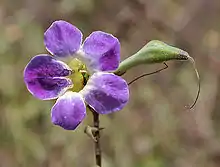

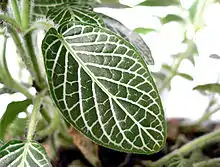
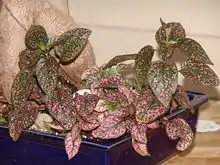
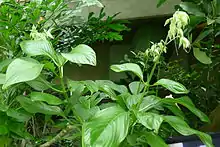
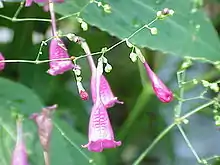


As of 2 December 2021, the Germplasm Resources Information Network accepts 217 genera,[16] while 206 accepted genera are listed by Plants of the World Online (the Royal Botanic Gardens, Kew).[17]
- Acanthopale C.B.Clarke
- Acanthopsis Harv.
- Acanthostelma Bidgood & Brummitt
- Acanthura Lindau
- Acanthus L. (bear's breech)
- Achyrocalyx Benoist
- Aechmanthera
- Adhatoda Mill. (sometimes included in Justicia)
- Afrofittonia Lindau
- Ambongia Benoist
- Ancistranthus Lindau (desert honeysuckle)
- Ancistrostylis T.Yamaz.
- Andrographis Wall. ex Nees (false waterwillow)
- Angkalanthus Balf.f.
- Anisacanthus Nees
- Anisosepalum E.Hossain
- Anisostachya Nees (sometimes included in Justicia)
- Anisotes Nees
- Anomacanthus R.D.Good
- Apassalus Kobuski
- Aphanosperma T.F.Daniel
- Aphelandra R.Br.
- Aphelandrella Mildbr.
- Ascotheca Heine
- Asystasia Blume
- Asystasiella Lindau
- Avicennia L.
- Ballochia Balf.f.
- Barleria L. (bush violets)
- Barleriola Oerst
- Benoicanthus Heine & A.Raynal
- Blechum P.Browne
- Blepharis Juss.
- Borneacanthus Bremek.
- Boutonia DC.
- Brachystephanus Nees
- Bravaisia DC.
- Brillantaisia P.Beauv.
- Calacanthus T.Anderson ex Benth. & Hook.f.
- Calophanoides (C.B.Clarke) Ridl. (sometimes included in Justicia)
- Calycacanthus K.Schum.
- Camarotea Scott-Elliot
- Carlowrightia A.Gray (wrightwort)
- Celerina Benoist
- Cephalacanthus Lindau
- Cephalophis Vollesen
- Chalarothyrsus Lindau
- Chamaeranthemum Nees
- Championella Bremek.
- Chileranthemum Oerst.
- Chlamydacanthus Lindau (sometimes included in Theileamea)
- Chlamydocardia Lindau
- Chlamydostachya Mildbr.
- Chroesthes Benoist
- Clinacanthus Nees
- Clistax Mart.
- Codonacanthus Nees
- Conocalyx Benoist
- Corymbostachys Lindau
- Cosmianthemum Bremek.
- Crabbea Harv.
- Crossandra Salisb.
- Crossandrella C.B.Clarke
- Cyclacanthus S.Moore
- Cylindrosolenium Lindau
- Cyphacanthus Leonard
- Dactylostegium Nees (sometimes included in Dicliptera)
- Danguya Benoist
- Dasytropis Urb.
- Dichazothece Lindau
- Dicladanthera F.Muell.
- Dicliptera Juss. (Foldwing)
- Didyplosandra Wight ex Bremek.
- Dipteracanthus Nees (sometimes included in Ruellia)
- Dischistocalyx T.Anderson ex Benth. & Hook.f.
- Dolichostachys Benoist
- Drejera Nees
- Drejerella Lindau (sometimes included in Justicia)
- Duosperma Dayton
- Dyschoriste Nees (snakeherb)
- Ecbolium Kurz
- Echinacanthus Nees
- Elytraria Michx. (scalystem)
- Encephalosphaera Lindau
- Epiclastopelma Lindau
- Eranthemum L.
- Eremomastax Lindau
- Eusiphon Benoist (often included in Ruellia)
- Filetia Miq.
- Fittonia Coem.
- Forcipella Baill.
- Forsythiopsis Baker (sometimes included in Oplonia)
- Geissomeria Lindl.
- Glossochilus Nees
- Golaea Chiov.
- Graphandra J.B.Imlay
- Graptophyllum Nees
- Gymnophragma Lindau
- Gymnostachyum Nees
- Gynocraterium Bremek.
- Gypsacanthus E.J.Lott et al.
- Haplanthodes Kuntze
- Harpochilus Nees
- Hemiadelphis Nees
- Hemigraphis Nees (sometimes included in Strobilanthes)
- Henrya Nees
- Herpetacanthus Nees
- Heteradelphia Lindau
- Holographis Nees
- Hoverdenia Nees
- Hulemacanthus S.Moore
- Hygrophila R.Br. (swampweed)
- Hypoestes (including Periestes)
- Ionacanthus Benoist
- Isoglossa Oerst.
- Isotheca Turrill
- Jadunia Lindau
- Juruasia Lindau
- Justicia L. (justicia, water-willow, shrimp plant)
- Kalbreyeriella Lindau
- Kosmosiphon Lindau
- Kudoacanthus Hosok.
- Lankesteria Lindl.
- Lasiocladus Bojer ex Nees
- Leandriella Benoist
- Lepidagathis Willd.
- Leptostachya Nees
- Liberatia Rizzini (sometimes included in Lophostachys)
- Linariantha B.L.Burtt & R.M.Sm.
- Lophostachys Pohl
- Louteridium S.Watson
- Lychniothyrsus Lindau
- Marcania J.B.Imlay
- Megalochlamys Lindau
- Megalostoma Leonard
- Megaskepasma Lindau
- Melittacanthus S.Moore
- Mellera S.Moore
- Mendoncia Vand.
- Metarungia Baden
- Mexacanthus T.F.Daniel
- Meyenia Nees
- Mimulopsis Schweinf.
- Mirandea Rzed.
- Monechma Hochst. (sometimes included in Justicia)
- Monothecium Hochst.
- Morsacanthus Rizzini
- Nelsonia R.Br.
- Neohallia Hemsl.
- Neriacanthus Benth.
- Neuracanthus Nees
- Odontonema Nees (toothedthread)
- Ophiorrhiziphyllon Kurz
- Oplonia Raf.
- Oreacanthus Benth.
- Orophochilus Lindau
- Pachystachys Nees
- Pachystrobilus: P. involucratus (Blume) Bremek.[18]
- Pelecostemon Leonard
- Pentstemonacanthus Nees
- Perenideboles Ram. (Goyena)
- Pericalypta Benoist
- Peristrophe Nees
- Petalidium Nees
- Phaulopsis Willd.
- Phialacanthus Benth.
- Phidiasia Urb.
- Phlogacanthus Nees
- Physacanthus Benth.
- Podorungia Baill.
- Poikilacanthus Lindau
- Polylychnis Bremek. (often included in Ruellia)
- Populina Baill.
- Pranceacanthus Wassh.
- Pseuderanthemum Radlk.
- Pseudocalyx Radlk.
- Pseudodicliptera Benoist
- Pseudoruellia Benoist
- Psilanthele Lindau
- Ptyssiglottis T.Anderson
- Pulchranthus V.M.Baum et al.
- Pupilla Rizzini (sometimes included in Justicia)
- Razisea Oerst.
- Rhinacanthus Nees
- Rhombochlamys Lindau
- Ritonia Benoist
- Rostellularia Rchb. (sometimes included in Justicia)
- Ruellia L. (Wild Petunia)
- Ruelliopsis C.B.Clarke
- Rungia Nees
- Ruspolia Lindau
- Ruttya Harv.
- Saintpauliopsis Staner (sometimes included in Staurogyne)
- Salpinctium T.J.Edwards
- Salpixantha Hook.
- Samuelssonia Urb. & Ekman
- Sanchezia Ruiz & Pav.
- Santapaua N.P.Balakr. & Subr. (sometimes included in Hygrophila)
- Sapphoa Urb.
- Satanocrater Schweinf.
- Sautiera Decne.
- Schaueria Nees
- Schwabea Endl. & Fenzl
- Sclerochiton Harv.
- Sebastiano-schaueria Nees
- Sericospora Nees
- Siphonoglossa Oerst. (tubetongue)
- Spathacanthus Baill.
- Sphacanthus Benoist
- Sphinctacanthus Benth.
- Spirostigma Nees
- Standleyacanthus Leonard
- Staurogyne Wall.
- Steirosanchezia Lindau
- Stenandriopsis S.Moore
- Stenandrium Nees (shaggytuft)
- Stenostephanus Nees
- Streblacanthus Kuntze
- Streptosiphon Mildbr.
- Strobilanthes Blume
- Strobilanthopsis S.Moore
- Styasasia S.Moore
- Suessenguthia Merxm.
- Synchoriste Baill.
- Taeniandra Bremek.
- Tarphochlamys Bremek.
- Teliostachya Nees
- Tessmanniacanthus Mildbr.
- Tetramerium Nees
- Theileamea Baill.
- Thunbergia Retz.
- Thysanostigma J.B.Imlay
- Tremacanthus S.Moore
- Triaenanthus Nees
- Trichanthera Kunth
- Trichaulax Vollesen
- Trichocalyx Balf.f.
- Trichosanchezia Mildbr.
- Ulleria Bremek. (often included in Ruellia)
- Vavara Benoist
- Vindasia Benoist
- Warpuria Stapf
- Whitfieldia Hook.
- Xantheranthemum Lindau
- Xerothamnella C.T.White
- Xylacanthus Aver. & K.S.Nguyen
- Yeatesia Small (Bractspike)
- Zygoruellia Baill.[19]
Excluded genera
- Thomandersia Baill. → Thomandersiaceae[20][21]
References
- "Family: Acanthaceae Juss., nom. cons". Germplasm Resources Information Network. United States Department of Agriculture. 2003-01-17. Retrieved 2011-07-29.
- Angiosperm Phylogeny Group (2009). "An update of the Angiosperm Phylogeny Group classification for the orders and families of flowering plants: APG III". Botanical Journal of the Linnean Society. 161 (2): 105–121. doi:10.1111/j.1095-8339.2009.00996.x.
- Witztum, A; Schulgasser, K (1995). "The mechanics of seed expulsion in Acanthaceae". Journal of Theoretical Biology. 176 (4): 531–542. Bibcode:1995JThBi.176..531W. doi:10.1006/jtbi.1995.0219.
- Awan, A.J., Aslam, M.S. (2014). "FAMILY ACANTHACEAE AND GENUS APHELANDRA: ETHNOPHARMACOLOGICAL AND PHYTOCHEMICAL REVIEW". International Journal of Pharmacy and Pharmaceutical Sciences. 6 (10): 44–55.
{{cite journal}}: CS1 maint: multiple names: authors list (link) - Wostmann, R; Liebezeit, G (2008). "Chemical composition of the mangrove holly Acanthus ilicifolius (Acanthaceae)—review and additional data". Senckenbergiana Maritima. 38: 31–37. doi:10.1007/bf03043866. S2CID 38592501.
- Bandaranayake, W. M. (1998). "Traditional and medicinal uses of mangroves". Mangroves and Salt Marshes. 2 (3): 133–148. doi:10.1023/a:1009988607044. S2CID 129317332.
- Chan, E. W. C.; Eng, S. Y.; Tan, Y. P.; Wong, Z. C.; Lye, P. Y.; Tan, L. N. (2012). "Antioxidant and Sensory Properties of Thai Herbal Teas with Emphasis on Thunbergia laurifolia Lindl". Chiang Mai J. Sci. 39 (4): 599–609.
- Nees, C. G. (1847). de Candolle, A. P. (ed.). "Acanthaceae". Prodromus Systematis Naturalis Regni Vegetabilis. 11: 46–519.
- Lindau, G. (1895). Engler, A.; Prantl, K. (eds.). "Acanthaceae". Die Natuirlichen Pflanzenfamilien. 4 (3b): 274–353.
- Bremekamp, C. E. B. (1965). "Delimitation and subdivision of the Acanthaceae". Bull. Bot. Surv. India. 7: 21–30.
- Scotland, R. W.; Vollesen, K. (2000). "Classification of Acanthaceae". Kew Bulletin. 55 (3): 513–589. doi:10.2307/4118776. JSTOR 4118776.
- Tripp, E. A.; Daniel, T. F.; Fatimah, S.; McDade, L. A. (2013). "Phylogenetic Relationships within Ruellieae (Acanthaceae) and a Revised Classification". International Journal of Plant Sciences. 174 (1): 97–137. doi:10.1086/668248. S2CID 84423889.
- Bremer, K.; Friis, E. M.; Bremer, B. (2004). "Molecular phylogenetic dating of asterid flowering plants shows Early Cretaceous diversification". Systematic Biology. 53 (3): 496–505. doi:10.1080/10635150490445913. PMID 15503676.
- Pigg, K. B.; Wehr, W. C. (2002). "Tertiary flowers, fruits, and seeds of Washington state and adjacent areas—Part III" (PDF). Washington Geology. 30: 3–16.
- Medus, J. (1975). "Palynologie de sediments tertiaires de Sénégal mé ridional". Pollen et Spores. 17: 545–608.
- "Acanthaceae GRIN-Global". npgsweb.ars-grin.gov. Retrieved 2 December 2021.
- "Acanthaceae Juss. | Plants of the World Online | Kew Science". Plants of the World Online. Retrieved 2 December 2021.
- The Plant List: Pachystrobilus (retrieved 21/11/2017)
- "Acanthaceae". Integrated Taxonomic Information System. Retrieved 2011-07-29.
- Wortley, A.H., Harris, D.J. & Scotland, R.W.; Harris, D. J.; Scotland, R. W. (2007). "On the Taxonomy and Phylogenetic Position of Thomandersia". Systematic Botany. 32 (2): 415–444. doi:10.1600/036364407781179716. S2CID 85726050.
{{cite journal}}: CS1 maint: multiple names: authors list (link) - "GRIN genera sometimes placed in Acanthaceae". Germplasm Resources Information Network. United States Department of Agriculture. Archived from the original on 2004-11-18. Retrieved 2011-07-29.
- Schwarzbach, Andrea E.; McDade, Lucinda A. (2002). "Phylogenetic relationships of the mangrove family Avicenniaceae based on chloroplast and nuclear ribosomal DNA sequences". Systematic Botany. 27 (1): 84–98. doi:10.1043/0363-6445-27.1.84 (inactive 2023-08-01). JSTOR 3093897.
{{cite journal}}: CS1 maint: DOI inactive as of August 2023 (link)
External links
- Tree of Life Acanthaceae
- Family Acanthaceae Flowers in Israel.
- Acanthaceae in BoDD – Botanical Dermatology Database
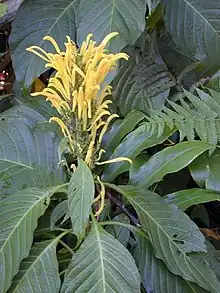
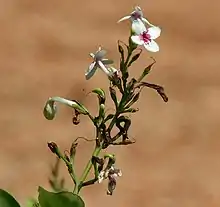
_W_IMG_1973.jpg.webp)